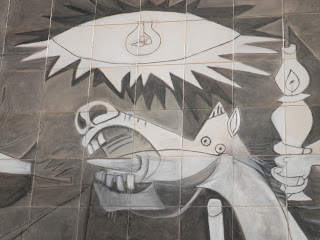The bombing raids took place in the afternoon of the 26th April 1937 and resulted in three-quarters of the town's buildings destroyed with the remainder suffering damage. It allowed the Nationalists to take over the city with little resistance in the following days. An eyewitness account, a foreign journalist Noel Monks writing for the "Daily Express"- he was one of the first on the scene - gives an idea of the destruction,
...The only things left standing were a church, a sacred Tree, symbol of the Basque people, and, just outside the town, a small munitions factory. There hadn't been a single anti-aircraft gun in the town. It had been mainly a fire raid....A sight that haunted me for weeks was the charred bodies of several women and children huddled together in what had been the cellar of a house. It had been a refugio.
Monks, Eyewitness, 1955
Picasso was commissioned to create a mural for the Spanish Pavilion at the 1936 Paris Exposition before the Guernica bombing. When news reached him of the atrocity he painted what was probably his first overtly political painting. The bull and the horse, symbols of Spain (the bull also used as a symbol for Picasso's ego) are central, though Picasso never gave a full explanation of the symbology within it. Also 'hidden' in the painting are a skull, a sword and the merging of some of the elements. Picasso's 'Guernica' has become one of the most recognised and talked about piece of artwork, copies of it are dotted around Spain including my locla town of Torre del Mar where it decorates the promenade.



No comments:
Post a Comment